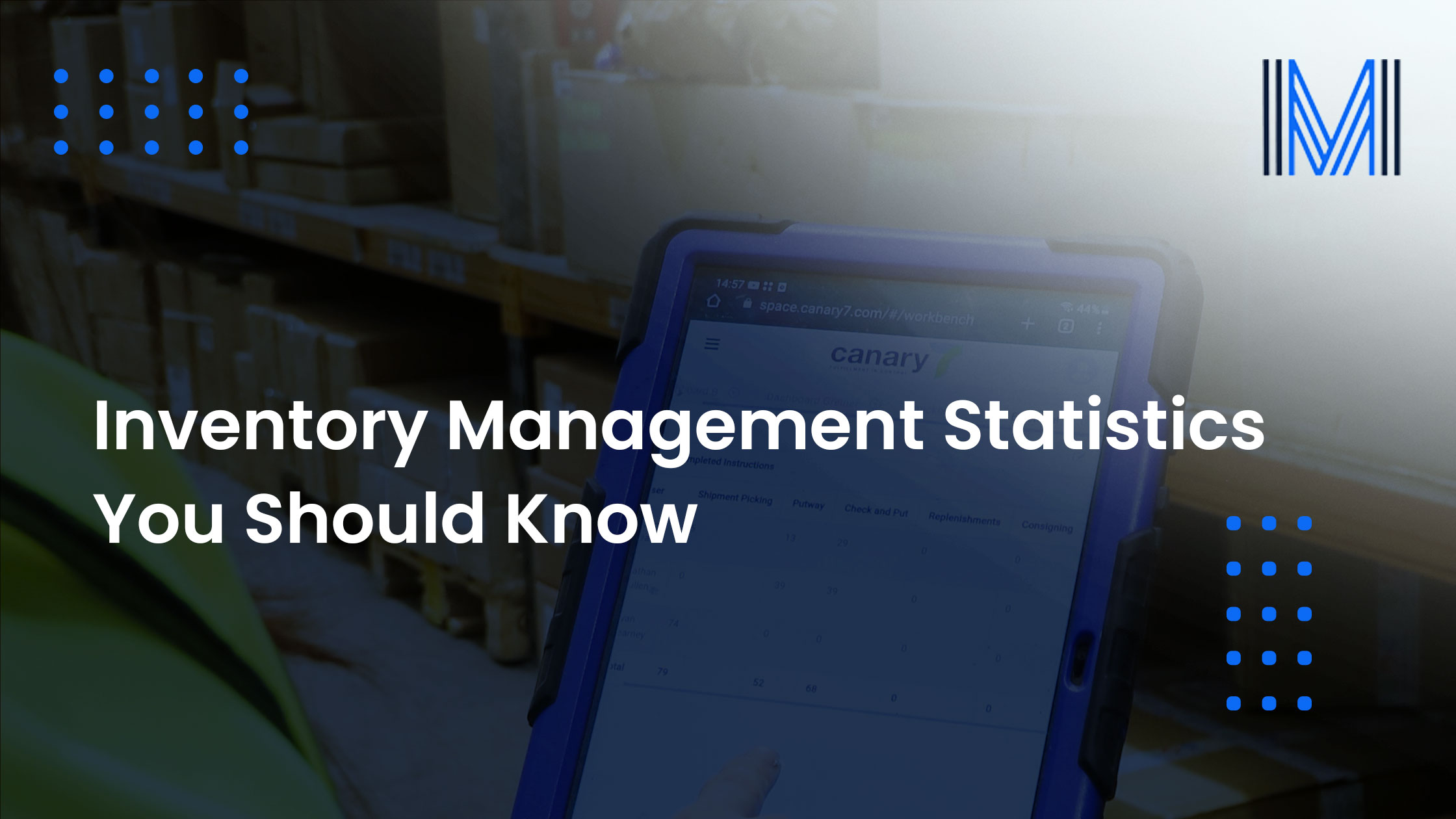07 Sep

To make well-informed decisions for your business, you need to be familiar with the latest inventory management statistics and trends. Inventory management is a crucial process for all retail businesses, whether you are a small startup or a large corporation. Understanding how inventory management works and the latest industry trends can help you optimize your operations, reduce costs, and improve customer satisfaction.
Let’s dive into some of the most critical inventory management statistics for 2024 and explore how they can impact your business.
The High Cost of Inventory Distortion
Worldwide, inventory distortion (including shrinkage, stockouts, and overstock) costs businesses an estimated $1.5 trillion annually. This figure has risen significantly in recent years, highlighting the importance of efficient inventory management. The reasons for such high costs are varied, but common culprits include poor forecasting, inaccurate data, and inefficient supply chain processes.
What You Can Do: To combat these losses, consider investing in advanced inventory management software that provides real-time data and predictive analytics. This can help you identify and address inefficiencies before they become costly problems.
The Impact of Stockouts on Order Fulfillment
A staggering 37% of businesses have shipped an order late because they inadvertently sold a product that was not in stock. With supply chain disruptions still a significant challenge post-pandemic, businesses must streamline their dock-to-stock processes to avoid delays.
What You Can Do: Implement a robust inventory tracking system that automatically updates stock levels across all sales channels. This will help you avoid selling items that are out of stock and ensure timely order fulfillment.
The Challenge of Manual Inventory Tracking
Despite advancements in technology, 41% of small businesses in the United States still track inventory manually or not at all. This method is prone to errors and can lead to significant issues such as stockouts or overstocking, both of which can hurt your bottom line.
What You Can Do: Transition to an automated inventory management system that reduces human error and provides accurate, real-time data. This will not only save time but also improve the accuracy of your inventory forecasts.
Reducing Inventory Costs Through Efficient Management
Reducing stockouts and overstocks can lower your overall inventory costs by up to 12%. Efficient inventory management practices, such as just-in-time (JIT) inventory and regular audits, can help you maintain optimal stock levels and reduce waste.
What You Can Do: Regularly review your inventory turnover rates and adjust your ordering practices accordingly. This can help you keep just the right amount of stock on hand, reducing both overstocking and stockouts.
Supply Chain Delays Still a Major Concern
Even in 2024, 35% of U.S. small businesses are still experiencing supply chain delays due to lingering effects of the COVID-19 pandemic and other global disruptions. These delays can severely impact customer satisfaction and lead to lost sales.
What You Can Do: Diversify your supplier base to reduce dependency on a single source. Additionally, consider increasing your safety stock levels to buffer against unexpected delays.
The Growing Importance of the Supply Chain Market
The global supply chain market is expected to experience a CAGR of 10.8% from 2024 to 2030, with the market value projected to reach nearly $45 billion by 2030. This growth underscores the increasing complexity and importance of supply chain management in today’s global economy.
What You Can Do: Stay ahead of the curve by investing in supply chain management technologies that offer greater visibility and control over your operations. This can help you adapt to market changes more quickly and maintain a competitive edge.
Supply Chain Management as a Competitive Advantage
A significant 59% of companies believe that efficient supply chain management gives them a competitive edge. Businesses that manage their supply chains effectively are better positioned to meet customer demands, reduce costs, and improve overall operational efficiency.
What You Can Do: Focus on continuous improvement in your supply chain processes. Regularly analyze your supply chain performance and look for areas where you can implement more efficient practices or technologies.
Reducing Supply Chain Costs: A Path to Doubling Profits

Reducing supply chain costs from 9% to 4% can potentially double your profits. In 2024, the average supply chain cost for industrial suppliers remains above 9%, a significant drag on profitability. Companies that have managed to lower this percentage through optimization strategies have seen a dramatic increase in their profit margins.
What You Can Do: Focus on optimizing your supply chain by negotiating better rates with suppliers, improving logistics efficiency, and adopting cost-saving technologies. Small reductions in supply chain costs can lead to substantial gains in profitability.
The Importance of a Proactive Supply Chain Network
Only 24% of companies currently have a proactive supply chain network. This is a slight improvement over previous years, but it still means that three-quarters of businesses are reactive rather than proactive. A proactive network allows businesses to anticipate market changes, manage supply and demand fluctuations, and mitigate risks such as stockouts or overstocking.
What You Can Do: Invest in predictive analytics and demand forecasting tools. By anticipating changes in the market, you can better prepare your supply chain to handle sudden shifts in demand or supply, ensuring smoother operations and higher customer satisfaction.
The Continued Reliance on Excel for Supply Chain Management
Despite the availability of advanced tools, 65% of supply chain managers still rely on Excel spreadsheets for inventory management. While Excel offers familiarity, it lacks the automation and real-time capabilities that modern inventory management software provides.
What You Can Do: Consider upgrading to a dedicated supply chain management system that offers real-time data, automation, and advanced analytics. This shift can enhance accuracy, reduce errors, and save valuable time for your management team.
The Rapid Growth of the Global Logistics Automation Market
The Global Logistics Automation Market is forecasted to grow at a CAGR of 13.1% from 2024 to 2030. By 2030, the market is expected to reach a valuation of nearly $90 billion. This surge is driven by the increasing adoption of automation technologies across supply chains, which enhance efficiency and reduce the need for manual labor.
What You Can Do: Explore how automation can be integrated into your supply chain processes. Technologies like automated warehouses, robotic process automation (RPA), and AI-driven logistics can significantly improve operational efficiency and reduce costs.
Enhancing Supply Chain Visibility and Accuracy
Supply chain visibility remains a top priority for companies globally, with 7% of businesses achieving full visibility in 2024, up from previous years. However, 65% still struggle with limited visibility, leading to inefficiencies and inaccuracies.
What You Can Do: Implement technologies such as RFID, IoT sensors, and blockchain to improve visibility across your supply chain. Full visibility allows you to track your inventory in real-time, reducing errors and improving decision-making.
The Prevalence of Daily Performance as a Key KPI
The most commonly used KPI for monitoring supply chains is daily performance, with 42% of companies tracking this metric. Daily performance KPIs provide immediate insights into the effectiveness of supply chain operations, helping businesses stay on track with their goals.
What You Can Do: Ensure that you have a robust system in place for tracking daily performance. This can involve setting up dashboards that provide real-time updates on key metrics, allowing you to make informed decisions quickly.
The Low Accuracy of Inventory Management in Retail
The average U.S. retail business has an inventory accuracy of only 64%. This figure highlights a critical area for improvement, as low accuracy can lead to stockouts, overstocking, and ultimately, lost sales.
What You Can Do: Improve your inventory accuracy by implementing item-level tagging systems like RFID. This technology can increase your inventory accuracy to over 95%, ensuring you have the right products in stock at the right time.
Leveraging Item-Level Tagging for Inventory Accuracy
Item-level tagging, when properly implemented, can boost inventory accuracy from 64% to 96%. This technology allows businesses to track individual items throughout the supply chain, significantly reducing the risk of errors.
What You Can Do: Invest in RFID or other item-level tagging technologies to enhance your inventory management. This will not only improve accuracy but also help you reduce costs associated with overstocking or stockouts.
Key Inventory Management Software Statistics for 2024
In today’s fast-paced business environment, efficient inventory management is crucial for maintaining profitability and customer satisfaction. As businesses continue to embrace digital transformation, inventory management software has become an essential tool. Below, we explore the latest inventory management software statistics for 2024 and provide insights into how these trends can impact your business.
The Growing Inventory Management Software Market
The global inventory management software market is projected to reach an estimated value of $4.6 billion by 2028, growing at a CAGR of 7.2% from 2024 onwards. This growth underscores the increasing recognition of the importance of these solutions in streamlining operations and enhancing efficiency.
What You Can Do: If your business is still relying on manual processes or outdated systems, now is the time to invest in modern inventory management software. These tools can automate various processes, reduce human error, and ultimately improve your bottom line.
Asia-Pacific Leads in RFID Adoption
The Asia-Pacific region continues to dominate the inventory management software market, driven by the rising demand for RFID technology. As e-commerce in the region expands rapidly, businesses are increasingly adopting RFID to enhance supply chain visibility and efficiency.
What You Can Do: Consider integrating RFID technology into your inventory management practices, especially if your business operates in or sources products from the Asia-Pacific region. RFID can significantly improve tracking accuracy and operational efficiency.
The Shift Toward Real-Time Inventory Visibility

Approximately 75% of retailers plan to leverage real-time inventory visibility by 2025, enabled by automation, sensors, and analytics. This shift reflects a growing recognition of the importance of having up-to-the-minute insights into inventory levels to optimize supply chain operations.
What You Can Do: Implement real-time inventory tracking tools that provide instant visibility into your stock levels. This can help you avoid stockouts, reduce excess inventory, and make more informed decisions.
Addressing Human Error in Warehouses
Human error remains the leading issue in 45% of warehouses worldwide, often resulting in costly mistakes such as mis-picks and inaccurate stock counts. Technology can play a critical role in minimizing these errors and improving overall accuracy.
What You Can Do: Invest in automation tools such as barcode scanners, RFID systems, and inventory management software to reduce the risk of human error and improve efficiency in your warehouse operations.
The Impact of RFID on Inventory Accuracy
Businesses using RFID technology report an impressive 96% inventory accuracy. This significant improvement highlights the effectiveness of RFID in tracking inventory and reducing discrepancies.
What You Can Do: If you’re not already using RFID, it’s worth considering as part of your inventory management strategy. The increased accuracy can lead to better inventory control, fewer stockouts, and improved customer satisfaction.
The Landscape of Inventory Management Software Vendors
As of 2024, there are over 80 software vendors offering inventory management solutions. With such a wide variety of options, it’s important to choose the one that best fits your business needs, whether it’s for basic inventory tracking or more complex supply chain management.
What You Can Do: Take the time to research and compare different inventory management software solutions. Consider factors like scalability, ease of use, integration capabilities, and customer support when making your decision.
The Rising Demand for Inventory Management Software
Demand for inventory management software has more than doubled over the past five years. As businesses increasingly recognize the benefits of automation and digital tools, the adoption of inventory management software is becoming more widespread.
What You Can Do: If your business hasn’t yet adopted inventory management software, it’s time to consider the advantages. Implementing the right software can streamline your operations, reduce costs, and improve overall efficiency.
The Challenge for Small Businesses
Despite the clear benefits, only 20% of small businesses currently use inventory management software. For many small businesses, cost and resource constraints are the primary barriers to adoption. However, investing in inventory management software can provide a significant return on investment by improving accuracy and reducing waste.
What You Can Do: Small businesses should prioritize investing in inventory management software early on. The initial investment can lead to long-term savings and better control over your inventory and supply chain operations.
Streamline Your Inventory Management with Meteor Space

Are you looking to outsource your inventory management to a trusted partner? Look no further! Meteor Space is a leading 3PL and fulfillment center, offering top-notch inventory management and stock control services. We provide secure storage for your inventory in our state-of-the-art warehouse and handle order fulfillment with unmatched efficiency.
At Meteor Space, we use the latest technology and software to manage your inventory, monitor stock levels, create accurate forecasts, and ensure timely replenishment. With our expert team on your side, you’ll never have to worry about stock outs or late deliveries. We provide full transparency, giving you a 360-degree view of all inventory and stock management operations we perform on your behalf.
Focus on growing your business while we take care of the rest. Ready to learn more about how we can help streamline your inventory management? Get in touch with Meteor Space today!


